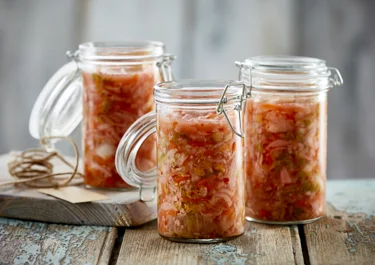
Kimchi

Instructions
Tips
For the best taste, use the freshest vegetables you can find. Fresh, crisp cabbage and firm radishes will give you the best texture and flavour. When preparing the vegetables, try to cut them uniformly. This ensures they ferment at the same rate and makes your kimchi easier to eat, whether you serve it with rice, as a filling, or the like.
Tips
Adjust the flavour and texture to your liking by experimenting with shorter or longer fermentation times. Shorter fermentation will result in a crunchier and less sour kimchi, while a longer period will make it softer and tangier.
Tips
Always use thoroughly cleaned containers for storing kimchi. Any residue from previous contents could affect the flavour and food safety. Similarly, ensure your fermentation jar closes tightly. An airtight seal helps maintain the anaerobic environment needed for proper fermentation and prevents any unwanted smells from escaping during fermentation.
Ingredients
Chinese cabbages, coarsely shredded (about 1.5 kg) | 2 |
|---|---|
Water | 3 l |
Coarse salt | 100 ml |
Daikon radishes or radishes, finely shredded | 450 g |
Finely shredded carrots | 200 g |
Cauliflower, very thinly sliced | 200 g |
Fish sauce | 4 tbsp |
Dried chilli flakes | 1 - 2 tbsp |
Garlic, finely grated | 2 tbsp |
Fresh ginger, finely grated | 2 tsp |
Sugar | 2 tsp |
Try our classic recipe for kimchi
If you love Korean cuisine, you absolutely need to try this kimchi recipe. Savour the rich and complex taste that comes from combining ginger, garlic, fish sauce, and chilli. Enjoy kimchi as a side dish to your favourite Asian dishes, or explore new and exciting ways to indulge in its delicious taste.
In authentic recipes, the cabbage used is napa cabbage, also known as Chinese cabbage. It has a mild flavour and a crunchy texture, which makes it ideal for kimchi. The leaves are tender yet sturdy enough to withstand the fermentation process.
Spicy paste with a subtle umami flavour
The paste in this kimchi is a flavour powerhouse, bringing together rich, savoury, and spicy elements. Fish sauce adds a deep umami richness with a subtle hint of the sea, while dried chilli flakes provide a fiery punch. Finely grated garlic contributes a robust and aromatic flavour, complemented by the zesty freshness of fresh ginger. A touch of sugar balances out the flavours, and as the kimchi ferments, these flavours meld and intensify, resulting in a tangy, spicy, and deeply satisfying side dish.
What is kimchi?
Kimchi is a traditional, fermented Korean side dish. Side dishes like this are called ‘banchan’ in Korean and are served alongside cooked rice to complement and enhance the flavours of the main dishes. It is made from fermented vegetables, primarily featuring Chinese cabbage.
This traditional banchan is seasoned with a mix of garlic, chilli, ginger, and often fish sauce, resulting in a tangy and spicy flavour. The variations of kimchi are vast, influenced by regional ingredients and personal tastes. But what does kimchi taste like? It depends, as there are many kimchi recipes out there, and the fermentation process varies. But in general, it is both tangy and spicy with hints of saltiness and umami richness from fermentation. Overall, it offers a complex taste with a delightful combination of sour, spicy, salty, and umami flavours.
Different ways to enjoy this Korean staple
Kimchi is a popular addition to many dishes across Korean cuisine and beyond. Serve it with a bowl of steamed rice, add it to ramen or layer it into stews and soups so its acidity and depth can enrich the broth’s flavour. You can also use it in fillings for dumplings or pancakes, offering a tangy twist. Whether you use it in everyday meals or as a key ingredient in special dishes, kimchi brings a distinct zest that takes any meal from simply delicious to utterly irresistible.
Serve it with our easy beef ramen, next to a plate of Korean chicken, add it to the filling in these homemade pork dumplings, or enjoy it on its own with other sides like this fresh, crunchy cabbage salad.
Shake things up with different ingredients
Kimchi is celebrated for its versatility, so start experimenting with different ingredients! Shrimp paste is a flavourful variation that adds depth and umami. Add about 1–2 tablespoons, depending on how pronounced you want the seafood flavour to be. Mix it into the paste of fish sauce, chilli flakes, garlic, ginger, and sugar before massaging it into the vegetables.
You can also try other traditional variations like white kimchi, which is a milder, non-spicy version that omits chilli flakes, often including a variety of vegetables and sometimes fruits like pear for a touch of sweetness. Young radish kimchi, made with tender radish greens, is another favoured variation, especially in the summer, and it is known for its crisp texture and refreshing taste. For those looking to explore a slight twist on the traditional flavour, try fruit kimchi by adding apples or persimmons, enhancing the natural sweetness and complexity of the side dish.










